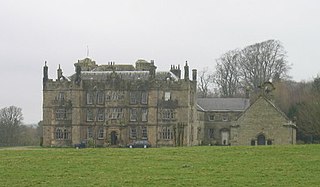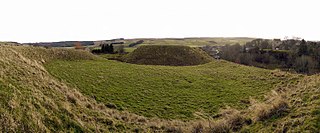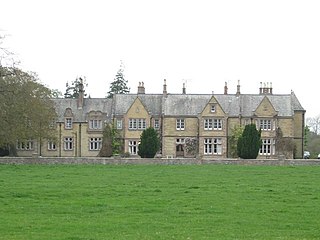
Craster is a small fishing village on the Northumberland coast of England, eight miles (13 km) from Alnwick. The next village to the north is Embleton. It is within the Northumberland Coast Area of Outstanding Natural Beauty.

Sherborne Castle is a 16th-century Tudor mansion southeast of Sherborne in Dorset, England, within the parish of Castleton. Originally built by Sir Walter Raleigh as Sherborne Lodge, and extended in the 1620s, it stands in a 1,200-acre (490 ha) park which formed a small part of the 15,000-acre (61 km2) Digby estate. Within the grounds lie the ruins of the 12th-century Sherborne Old Castle, now in the care of English Heritage.

Belsay is a village and civil parish in Northumberland, England. The village is about 5 miles (10 km) from Ponteland on the A696, which links the village with Newcastle upon Tyne and Jedburgh. The population of the civil parish was 436 at the 2001 census, increasing to 518 at the 2011 Census.

Callaly Castle is a Grade I listed building and a substantial country house to the north of the village of Callaly, which is some 14.5 km (9.0 mi) to the west of Alnwick, Northumberland, England.

Chipchase Castle is a 17th-century Jacobean mansion incorporating a substantial 14th-century pele tower, which stands north of Hadrian's Wall, near Wark on Tyne, between Bellingham and Hexham in Northumberland, England. It is a Scheduled Ancient Monument and a Grade I listed building.

Coupland Castle is situated in the village of Coupland, 4 miles (6 km) to the north-west of Wooler, Northumberland, England. It is a Grade I listed building. The Grade I listed "castle" is actually a tower house "built after 1584, with irregular later additions".

Elsdon Castle is a castle in the village of Elsdon about 10 miles (16 km) to the southwest of Rothbury, in Northumberland, England, and also known as Mote Hills. The site is a Scheduled Ancient Monument.

Featherstone Castle, a Grade I listed building, is a large Gothic style country mansion situated on the bank of the River South Tyne about 3 miles (5 km) southwest of the town of Haltwhistle in Northumberland, England.

Netherwitton Hall is a mansion house, and a Grade I listed building at Netherwitton, near Morpeth, Northumberland, England.

Adderstone Hall is a privately owned Georgian Grecian mansion situated on the bank of the River Warn near Lucker, Northumberland. It is a Grade II* listed building from which the present owners operate a holiday park.

Bellister Castle is a National Trust owned castellated 19th-century mansion house attached to the ruinous remains of a 14th-century tower house, near Haltwhistle, Northumberland, England. It is a Scheduled Ancient Monument and a Grade I listed building.

Lemmington Hall is an 18th-century country mansion incorporating a 15th-century tower house, situated near Edlingham, Northumberland, England. It is a Grade II* listed building. The original tower house built for the Beadnall family in the early 15th century was a four-storey construction which was reduced in height in the 17th century when Nicholas Fenwick converted the building into a country house.

Belsay Castle is a 14th-century medieval castle situated at Belsay, Northumberland, England. It is a Scheduled Monument and a Grade I listed building.
Little Harle Tower is a Grade II* listed privately owned country house with 15th-century origins, located at Little Harle, Kirkwhelpington, Northumberland.

Elsdon Tower is a Grade I listed medieval tower house converted for use as a Rectory situated at Elsdon, Northumberland. Originally part of the estate of Elsdon Castle, it later become a rectory and is now a private residence. The original construction dates from the 15th century and has been modified several times.

Hesleyside Hall is a privately owned 18th-century country house and the ancestral home of the Border reiver Charlton family about 2 miles (3 km) west of Bellingham, Northumberland. It is a Grade II* listed building.

Ribston Hall is a privately owned 17th-century country mansion situated on the banks of the River Nidd, at Great Ribston, near Knaresborough, North Yorkshire, England. It is a Grade II* listed building.

The Wick is a Grade I listed Georgian house in Richmond, Greater London, located at the corner of Nightingale Lane and Richmond Hill. The house, designed in 1775 by architect Robert Mylne for Lady St. Aubyn, was for many years the family home of actor Sir John Mills, who sold it to Ronnie Wood of the rock band Faces in 1971. From 1996 it was owned by Pete Townshend of the Who who sold it in 2021 for £15,000,000

Burneside Hall is a converted medieval pele tower in Burneside, Cumbria, England.

Carham Hall is a grade II listed building near Carham in Northumberland, England. The site, on the Scottish border, was previously occupied by a medieval tower house, built as a defence from border reivers. The Compton family purchased the estate in 1754 and the following year erected the first Carham Hall, a relatively plain building in the Classical style. The hall passed to the Hodgson family and in 1870 Richard Hodgson-Huntley ordered it be rebuilt on a grander scale, in four bays. The hall and estate were afterwards owned by the Perkins family, a daughter of which, Nancy, married William Matthew Burrell in 1903. Nancy Burrell commissioned Scottish architect James Bow Dunn to extend the hall in 1920. This extension added a further four bays to the western end of the structure, creating a larger, linear building. The house was later owned by Sir Thomas Straker-Smith.


















